2005 CHEVROLET KODIAK tow
[x] Cancel search: towPage 295 of 374
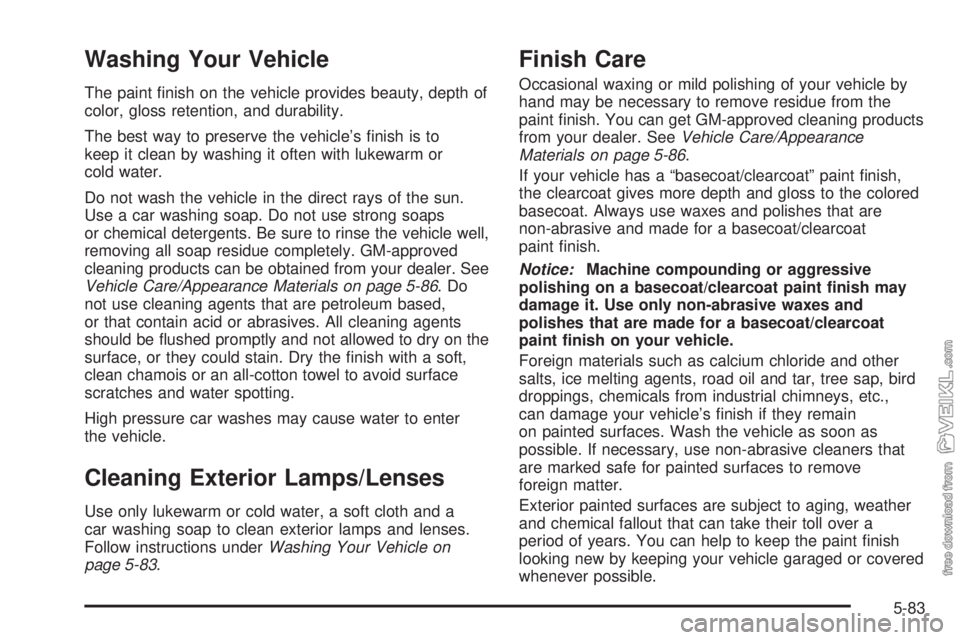
Washing Your Vehicle
The paint finish on the vehicle provides beauty, depth of
color, gloss retention, and durability.
The best way to preserve the vehicle’s finish is to
keep it clean by washing it often with lukewarm or
cold water.
Do not wash the vehicle in the direct rays of the sun.
Use a car washing soap. Do not use strong soaps
or chemical detergents. Be sure to rinse the vehicle well,
removing all soap residue completely. GM-approved
cleaning products can be obtained from your dealer. See
Vehicle Care/Appearance Materials on page 5-86.Do
not use cleaning agents that are petroleum based,
or that contain acid or abrasives. All cleaning agents
should be flushed promptly and not allowed to dry on the
surface, or they could stain. Dry the finish with a soft,
clean chamois or an all-cotton towel to avoid surface
scratches and water spotting.
High pressure car washes may cause water to enter
the vehicle.
Cleaning Exterior Lamps/Lenses
Use only lukewarm or cold water, a soft cloth and a
car washing soap to clean exterior lamps and lenses.
Follow instructions underWashing Your Vehicle on
page 5-83.
Finish Care
Occasional waxing or mild polishing of your vehicle by
hand may be necessary to remove residue from the
paint finish. You can get GM-approved cleaning products
from your dealer. SeeVehicle Care/Appearance
Materials on page 5-86.
If your vehicle has a “basecoat/clearcoat” paint finish,
the clearcoat gives more depth and gloss to the colored
basecoat. Always use waxes and polishes that are
non-abrasive and made for a basecoat/clearcoat
paint finish.
Notice:Machine compounding or aggressive
polishing on a basecoat/clearcoat paint �nish may
damage it. Use only non-abrasive waxes and
polishes that are made for a basecoat/clearcoat
paint �nish on your vehicle.
Foreign materials such as calcium chloride and other
salts, ice melting agents, road oil and tar, tree sap, bird
droppings, chemicals from industrial chimneys, etc.,
can damage your vehicle’s finish if they remain
on painted surfaces. Wash the vehicle as soon as
possible. If necessary, use non-abrasive cleaners that
are marked safe for painted surfaces to remove
foreign matter.
Exterior painted surfaces are subject to aging, weather
and chemical fallout that can take their toll over a
period of years. You can help to keep the paint finish
looking new by keeping your vehicle garaged or covered
whenever possible.
5-83
Page 296 of 374
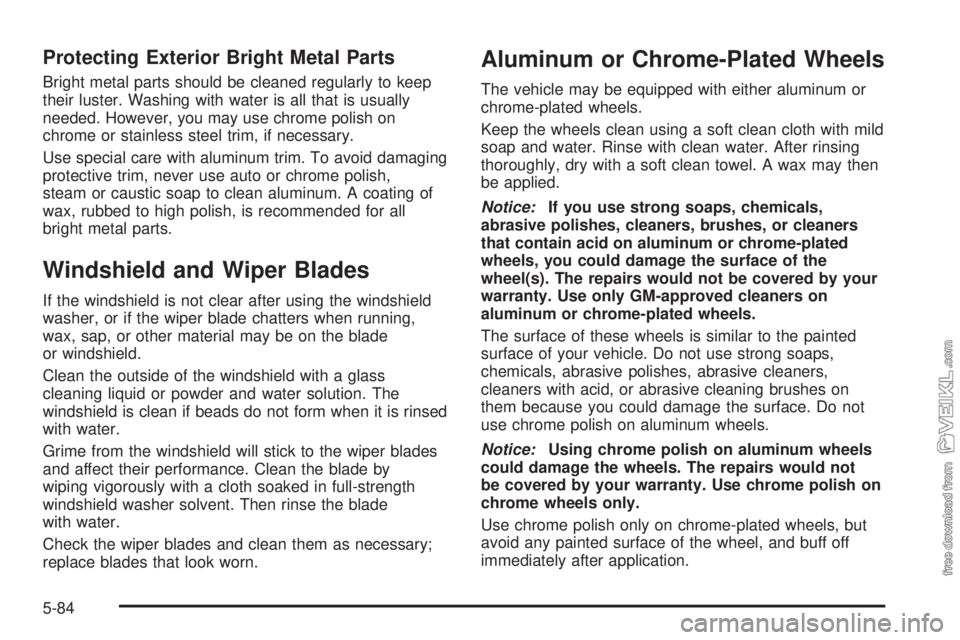
Protecting Exterior Bright Metal Parts
Bright metal parts should be cleaned regularly to keep
their luster. Washing with water is all that is usually
needed. However, you may use chrome polish on
chrome or stainless steel trim, if necessary.
Use special care with aluminum trim. To avoid damaging
protective trim, never use auto or chrome polish,
steam or caustic soap to clean aluminum. A coating of
wax, rubbed to high polish, is recommended for all
bright metal parts.
Windshield and Wiper Blades
If the windshield is not clear after using the windshield
washer, or if the wiper blade chatters when running,
wax, sap, or other material may be on the blade
or windshield.
Clean the outside of the windshield with a glass
cleaning liquid or powder and water solution. The
windshield is clean if beads do not form when it is rinsed
with water.
Grime from the windshield will stick to the wiper blades
and affect their performance. Clean the blade by
wiping vigorously with a cloth soaked in full-strength
windshield washer solvent. Then rinse the blade
with water.
Check the wiper blades and clean them as necessary;
replace blades that look worn.
Aluminum or Chrome-Plated Wheels
The vehicle may be equipped with either aluminum or
chrome-plated wheels.
Keep the wheels clean using a soft clean cloth with mild
soap and water. Rinse with clean water. After rinsing
thoroughly, dry with a soft clean towel. A wax may then
be applied.
Notice:If you use strong soaps, chemicals,
abrasive polishes, cleaners, brushes, or cleaners
that contain acid on aluminum or chrome-plated
wheels, you could damage the surface of the
wheel(s). The repairs would not be covered by your
warranty. Use only GM-approved cleaners on
aluminum or chrome-plated wheels.
The surface of these wheels is similar to the painted
surface of your vehicle. Do not use strong soaps,
chemicals, abrasive polishes, abrasive cleaners,
cleaners with acid, or abrasive cleaning brushes on
them because you could damage the surface. Do not
use chrome polish on aluminum wheels.
Notice:Using chrome polish on aluminum wheels
could damage the wheels. The repairs would not
be covered by your warranty. Use chrome polish on
chrome wheels only.
Use chrome polish only on chrome-plated wheels, but
avoid any painted surface of the wheel, and buff off
immediately after application.
5-84
Page 355 of 374
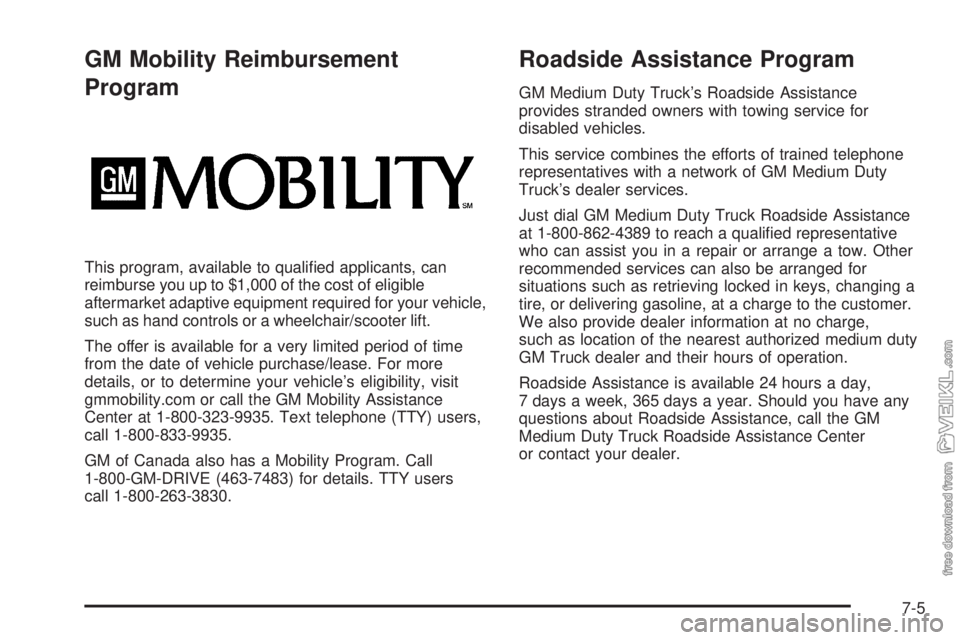
GM Mobility Reimbursement
Program
This program, available to qualified applicants, can
reimburse you up to $1,000 of the cost of eligible
aftermarket adaptive equipment required for your vehicle,
such as hand controls or a wheelchair/scooter lift.
The offer is available for a very limited period of time
from the date of vehicle purchase/lease. For more
details, or to determine your vehicle’s eligibility, visit
gmmobility.com or call the GM Mobility Assistance
Center at 1-800-323-9935. Text telephone (TTY) users,
call 1-800-833-9935.
GM of Canada also has a Mobility Program. Call
1-800-GM-DRIVE (463-7483) for details. TTY users
call 1-800-263-3830.
Roadside Assistance Program
GM Medium Duty Truck’s Roadside Assistance
provides stranded owners with towing service for
disabled vehicles.
This service combines the efforts of trained telephone
representatives with a network of GM Medium Duty
Truck’s dealer services.
Just dial GM Medium Duty Truck Roadside Assistance
at 1-800-862-4389 to reach a qualified representative
who can assist you in a repair or arrange a tow. Other
recommended services can also be arranged for
situations such as retrieving locked in keys, changing a
tire, or delivering gasoline, at a charge to the customer.
We also provide dealer information at no charge,
such as location of the nearest authorized medium duty
GM Truck dealer and their hours of operation.
Roadside Assistance is available 24 hours a day,
7 days a week, 365 days a year. Should you have any
questions about Roadside Assistance, call the GM
Medium Duty Truck Roadside Assistance Center
or contact your dealer.
7-5
Page 356 of 374
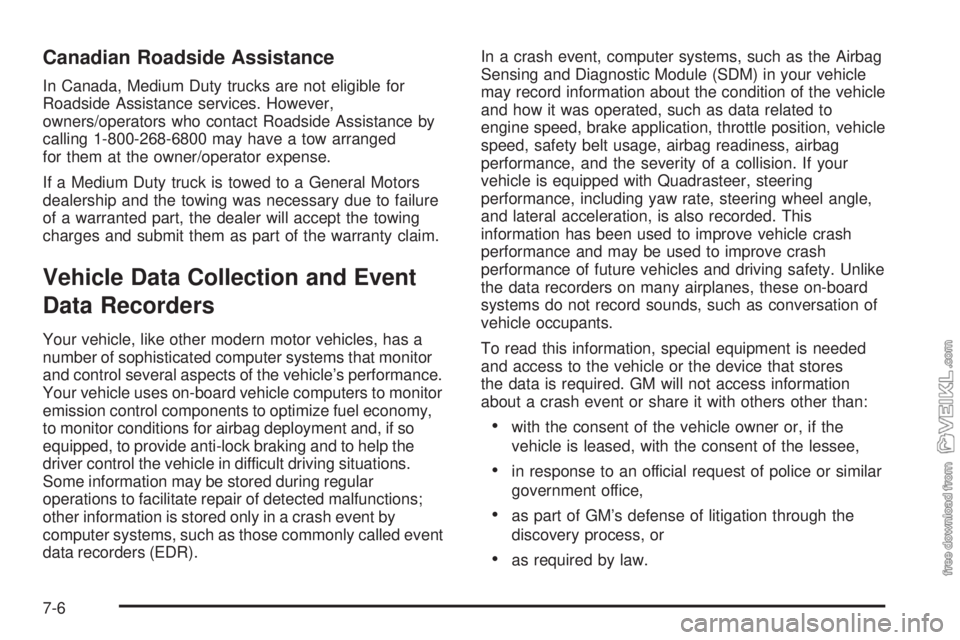
Canadian Roadside Assistance
In Canada, Medium Duty trucks are not eligible for
Roadside Assistance services. However,
owners/operators who contact Roadside Assistance by
calling 1-800-268-6800 may have a tow arranged
for them at the owner/operator expense.
If a Medium Duty truck is towed to a General Motors
dealership and the towing was necessary due to failure
of a warranted part, the dealer will accept the towing
charges and submit them as part of the warranty claim.
Vehicle Data Collection and Event
Data Recorders
Your vehicle, like other modern motor vehicles, has a
number of sophisticated computer systems that monitor
and control several aspects of the vehicle’s performance.
Your vehicle uses on-board vehicle computers to monitor
emission control components to optimize fuel economy,
to monitor conditions for airbag deployment and, if so
equipped, to provide anti-lock braking and to help the
driver control the vehicle in difficult driving situations.
Some information may be stored during regular
operations to facilitate repair of detected malfunctions;
other information is stored only in a crash event by
computer systems, such as those commonly called event
data recorders (EDR).In a crash event, computer systems, such as the Airbag
Sensing and Diagnostic Module (SDM) in your vehicle
may record information about the condition of the vehicle
and how it was operated, such as data related to
engine speed, brake application, throttle position, vehicle
speed, safety belt usage, airbag readiness, airbag
performance, and the severity of a collision. If your
vehicle is equipped with Quadrasteer, steering
performance, including yaw rate, steering wheel angle,
and lateral acceleration, is also recorded. This
information has been used to improve vehicle crash
performance and may be used to improve crash
performance of future vehicles and driving safety. Unlike
the data recorders on many airplanes, these on-board
systems do not record sounds, such as conversation of
vehicle occupants.
To read this information, special equipment is needed
and access to the vehicle or the device that stores
the data is required. GM will not access information
about a crash event or share it with others other than:
•with the consent of the vehicle owner or, if the
vehicle is leased, with the consent of the lessee,
•in response to an official request of police or similar
government office,
•as part of GM’s defense of litigation through the
discovery process, or
•as required by law.
7-6
Page 357 of 374
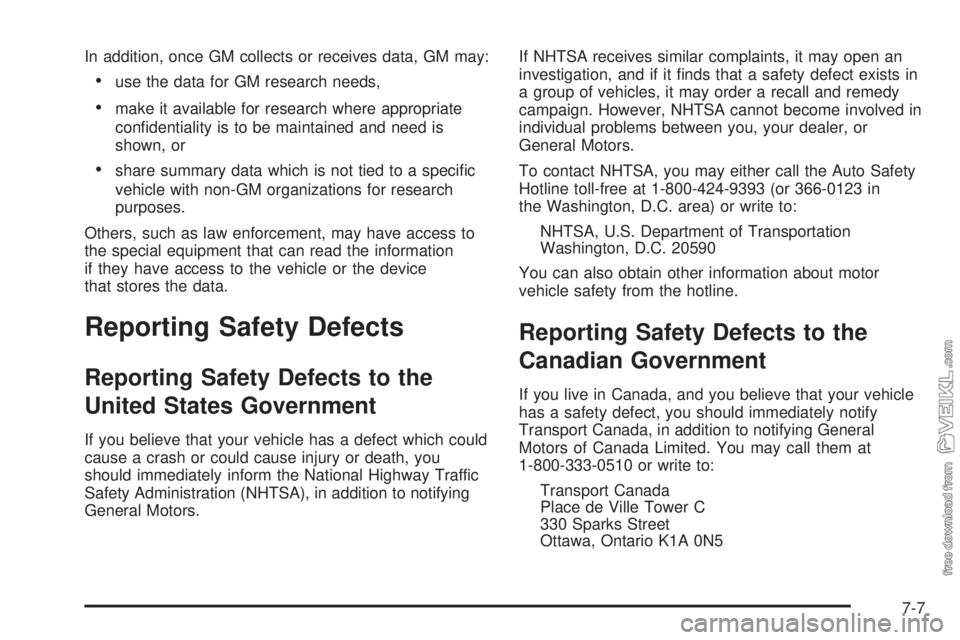
In addition, once GM collects or receives data, GM may:
•use the data for GM research needs,
•make it available for research where appropriate
confidentiality is to be maintained and need is
shown, or
•share summary data which is not tied to a specific
vehicle with non-GM organizations for research
purposes.
Others, such as law enforcement, may have access to
the special equipment that can read the information
if they have access to the vehicle or the device
that stores the data.
Reporting Safety Defects
Reporting Safety Defects to the
United States Government
If you believe that your vehicle has a defect which could
cause a crash or could cause injury or death, you
should immediately inform the National Highway Traffic
Safety Administration (NHTSA), in addition to notifying
General Motors.If NHTSA receives similar complaints, it may open an
investigation, and if it finds that a safety defect exists in
a group of vehicles, it may order a recall and remedy
campaign. However, NHTSA cannot become involved in
individual problems between you, your dealer, or
General Motors.
To contact NHTSA, you may either call the Auto Safety
Hotline toll-free at 1-800-424-9393 (or 366-0123 in
the Washington, D.C. area) or write to:
NHTSA, U.S. Department of Transportation
Washington, D.C. 20590
You can also obtain other information about motor
vehicle safety from the hotline.
Reporting Safety Defects to the
Canadian Government
If you live in Canada, and you believe that your vehicle
has a safety defect, you should immediately notify
Transport Canada, in addition to notifying General
Motors of Canada Limited. You may call them at
1-800-333-0510 or write to:
Transport Canada
Place de Ville Tower C
330 Sparks Street
Ottawa, Ontario K1A 0N5
7-7
Page 365 of 374

Driving (cont.)
Drunken....................................................... 4-2
Freeway.....................................................4-22
Hill and Mountain Roads..............................4-24
In Rain and on Wet Roads...........................4-18
Rocking Your Vehicle to Get it Out.................4-30
Tow Hooks.................................................4-31
Winter........................................................4-26
Dual Tire Operation.........................................5-72
E
Electrical System
Add-On Equipment......................................5-88
Fuses and Circuit Breakers...........................5-89
Fusible Links..............................................5-89
Headlamp Wiring.........................................5-88
Instrument Panel Fuse Block.........................5-89
Power Windows and Other Power Options......5-89
Underhood Fuse Block.................................5-92
Windshield Wiper Fuses...............................5-88
Engine
Air Cleaner/Filter.........................................5-33
Alarm and Automatic Shutdown.....................2-18
Battery.......................................................5-55
Change Engine Oil Light...............................3-38
Check and Service Engine Soon Light............3-36Engine (cont.)
Checks Before Operating..............................2-22
Coolant..............................................5-36, 5-38
Coolant Heater............................................2-24
Coolant Temperature Gage...........................3-35
Diesel Engine Exhaust Brake........................2-25
Exhaust.....................................................2-43
Exhaust Restrictor.......................................2-21
Fan Noise..................................................5-45
High Idle System.........................................2-19
Oil .....................................................5-22, 5-26
Oil Life System...........................5-29, 5-31, 5-32
Overheating................................................5-38
Overspeed Warning Light..............................3-39
Reduced Power Light...................................3-41
Shutdown Warning Light...............................3-39
Speed Limiter.............................................3-26
Starter Over-Crank Protection........................2-12
Starting Your Diesel.....................................2-14
Starting Your Gasoline..................................2-12
Entry Lighting.................................................3-17
Event Data Recorders (EDR)............................. 7-6
Exhaust Brake Indicator Light...........................3-40
Exhaust Restrictor...........................................2-21
Extender, Safety Belt.......................................1-26
Exterior Lamps...............................................3-14
5
Page 372 of 374

Securing a Child Restraint
Center Rear Seat Position (Crew Cab) or
Center Front Position................................1-42
Rear Outside Seat Position...........................1-40
Right Front Seat Position..............................1-44
Service........................................................... 5-3
Doing Your Own Work................................... 5-4
Engine Soon Light.......................................3-36
Publications Ordering Information..................... 7-8
Transmission Warning Light..........................3-31
Two Safety Cautions about Engine Fan
Breakage.................................................. 5-5
Servicing Your Airbag-Equipped Vehicle..............1-59
Setting the Time.............................................3-45
Sheet Metal Damage.......................................5-85
Shoulder Belt Height Adjuster...........................1-21
Signals, Turn and Lane-Change.......................... 3-8
Sliding Rear Windows.....................................2-10
Snow Plow....................................................4-34
Specifications, Capacities.................................5-95
Speedometer..................................................3-26
Split Bench Seat.............................................. 1-6
Starting Your Diesel Engine..............................2-14
Starting Your Gasoline Engine..........................2-12
Steering........................................................4-11
Steering Wheel, Tilt Wheel................................. 3-7Storage Areas................................................2-47
Center Console Storage Area........................2-47
Stuck in Sand, Mud, Ice or Snow......................4-30
Sun Visors.....................................................2-10
Suspension, Air..............................................2-42
Switchbanks, Instrument Panel..........................3-18
T
Tachometer....................................................3-26
Theft-Deterrent, Radio.....................................3-57
Tilt Wheel........................................................ 3-7
Tires.............................................................5-70
Aluminum or Chrome-Plated Wheels,
Cleaning.................................................5-84
Cleaning....................................................5-85
Dual Tire Operation.....................................5-72
If a Tire Goes Flat.......................................5-78
Inflation -- Tire Pressure...............................5-71
Tightening the Wheel Nuts............................5-73
Wheel Alignment and Tire Balance.................5-73
Wheel Loading............................................5-71
Wheel Replacement.....................................5-77
When It Is Time for New Tires......................5-72
Top Strap......................................................1-39
Tow Hooks.....................................................4-31
12
Page 373 of 374

Towing
Power Take-Off (PTO)..................................4-38
Your Vehicle...............................................4-35
Traction
Control System (TCS)..................................4-10
Trailer
Connections................................................4-37
Trailer Brake Hand Control Valve........................ 4-8
Transmission
Fluid, Automatic...........................................5-34
Fluid, Manual..............................................5-35
Service Warning Light..................................3-31
Temperature Gage.......................................3-39
Transmission Operation, Automatic....................2-28
Transmission Operation, Manual........................2-29
Trip Odometer................................................3-26
Turn and Lane-Change Signals.......................... 3-8
Turn Signal/Multifunction Lever........................... 3-7
Two-Speed Rear Axle Electric Shift Control.........2-26U
Understanding Radio Reception........................3-57
V
Vehicle
Control........................................................ 4-5
Damage Warnings........................................... iv
Loading......................................................4-32
Symbols......................................................... iv
Vehicle Data Collection and Event Data
Recorders.................................................... 7-6
Vehicle Identification
Number (VIN).............................................5-87
Service Parts Identification Label...................5-88
Service Statement.......................................5-87
Ventilation Adjustment......................................3-23
Visors...........................................................2-10
Voltmeter Gage..............................................3-30
13